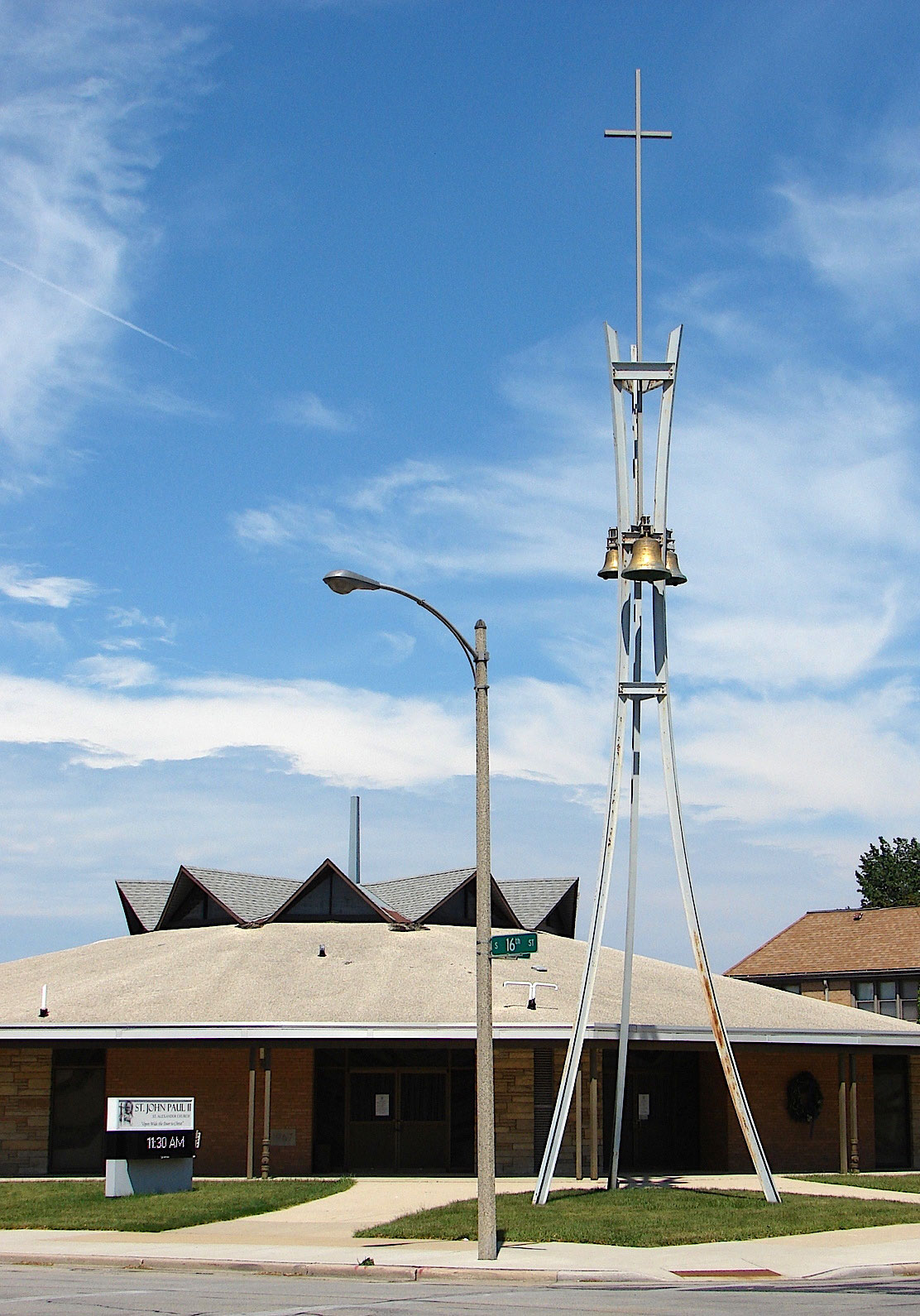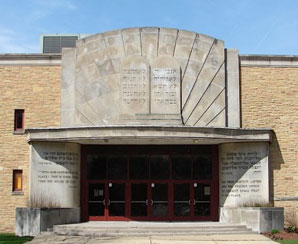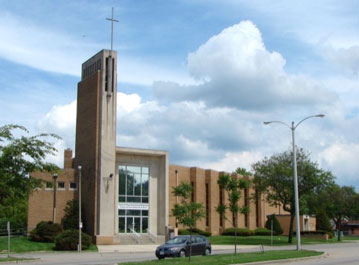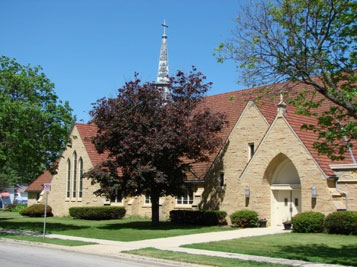Modernism
Milwaukee has an impressive collection of modern religious buildings, mostly dating from the late 1950s through the 1960s. There are also several distinctive modern churches and synagogues in the suburban communities of the metropolitan area, including Frank Lloyd Wright’s Annunciation Greek Orthodox Church. Wright’s famous church, designed in 1956 and completed in 1962, is located just outside the Milwaukee city limits in the city of Wauwatosa. The presence of such an unusual church may have inspired Milwaukee architects to experiment with unconventional building forms in their own church commissions.
Architectural historians have proposed a variety of origins for modern architecture, based on varying definitions of modern. The Prairie School houses of Frank Lloyd Wright and the Art Deco buildings of the late 1920s and 1930s were certainly considered modern in their day, and meet one definition of modern architecture in that their forms and details are not based on historical styles. There is one church in Milwaukee with some Prairie School features (East Side Baptist at Prospect Avenue and Park Place, built in 1912) and one with Art Deco features (St. Rita’s Catholic at Cass and Pleasant Streets, built in 1936). All of the other churches and synagogues in Milwaukee that could be described as modern were built after World War II.
From the late 1940s through the 1950s, several Jewish congregations built modern synagogues in the area north and west of Sherman Park on the North Side. Although these buildings are mostly quite plain, a few include ornament in the Art Moderne style, a simplified version of the Art Deco that dates from the 1930s to the early postwar years. A good example is the entrance to Beth El Ner Tamid Synagogue (now Parklawn Assembly of God Church) at Sherman Boulevard north of Fond Du Lac Avenue, built in 1948.
As their religious practices are based on traditions that are many centuries old, both Christian and Jewish congregations have been more conservative in adopting modern architecture than clients for other types of buildings. From the end of World War II through the 1950s, about one-third of the places of worship constructed in Milwaukee were in one of the historical revival styles, with the Gothic Revival being the most common. At the same time, modernism had almost completely supplanted the historical revival styles for all other building types. From the 1960s to the present, however, almost all of the city’s new places of worship have been modern in style, with the small number of exceptions being mainly Colonial Revival churches.
Architects who designed religious buildings did not abandon the historical revival styles at a single stroke. There are distinctly modern churches in Milwaukee, showing no hint of historicism, built at the same time as quite traditional Gothic Revival churches. A few such pairs were even designed by the same architects. For example, the firm of Steffen and Kemp designed the thoroughly modern Walther Memorial Lutheran Church, built in 1954, and the Gothic Revival Atonement Lutheran Church, built in 1958. In both cases, the architects were undoubtedly responding to the wishes of their clients. While the historical revival styles remained popular for churches into the late 1950s, many congregations chose to build modern churches as a way of proclaiming the continued relevance of Christianity in contemporary postwar society.
The increasing popularity of modern architecture coincided with a boom in the construction of religious buildings. In the years following World War II, the City of Milwaukee aggressively annexed unincorporated land at its boundaries, more than doubling in size from 44 square miles of land area in 1946 to its present 96 square miles by the end of the 1950s. High rates of new household formation after the war and the construction of new housing tracts in the city’s outermost neighborhoods fueled the demand for new places of worship. There are more than 120 extant places of worship in Milwaukee that were built from 1945 to 1970.
One popular modern form, often called the A-frame church, was common from the early 1950s to the mid-1960s. While a true A-frame building has a steeply pitched gable roof that rises from the ground and therefore also forms the building’s side walls, the modified A-frame as used in many postwar churches typically has the two roof planes extending from low side walls. The design is clearly modern but also traditional, as the soaring interior space is reminiscent of Gothic Revival churches and the exterior form is immediately recognizable as a place of Christian worship. Milwaukee has a dozen A-frame churches, of which St. Paul’s Lutheran (now One God Ministry) at 73rd and Burleigh Streets is a typical example.

By the late 1950s, architects were experimenting with a wide variety of new forms for places of worship. Setting aside the historical revival styles liberated architects from the use of traditional building forms as well as traditional styles of ornamentation. If a church no longer had to look like a church, it might look like a flying saucer, a tent, or anything that the architect might imagine. In the 1960s, novelty for its own sake appears to have become more popular in church and synagogue design.
Along with these new exterior forms came new seating plans, particularly curved and polygonal arrangements. Some modern churches retained the traditional arrangement of pews in straight rows on either side of a central aisle, but a variety of other designs came into common use at this time. These more centralized rather than axial plans, along with new structural systems that allowed for long roof spans without interior columns, brought the congregation closer to the clergy and eliminated the visual obstruction of columns in the worship space. While some Protestant denominations had been using more centralized seating arrangements for many years, several new Catholic churches in Milwaukee incorporated these types of seating plans beginning in the mid-1960s, following the liturgical reforms of the Second Vatican Council.
Although modern churches and synagogues vary widely in their forms, many share certain characteristics. They are generally smaller than their pre-World War II counterparts. Few accommodate as many as 1,000 worshippers at a time, while many provide seating for fewer than half that number. Although the Catholic churches still tend to be larger than the Protestant churches and synagogues, they are generally somewhat smaller than the Catholic churches of the nineteenth and early twentieth centuries. The tendency to smaller buildings is characteristic of the period rather than the modern style, as the postwar Gothic Revival and Colonial Revival churches also tend to be smaller than prewar examples. This trend is partially reversed in the later 1970s and 1980s, with the rise of the suburban megachurch.
While postwar churches and synagogues are generally smaller than their prewar counterparts, the properties on which they sit are often considerably larger. Frequently built in the city’s outermost neighborhoods where residential density is relatively low, these new places of worship require large parking lots since almost all of their users travel by car. They also tend to have considerably more landscaping than the older, inner-city religious buildings. Those older places of worship are often sited close to the sidewalks and take up nearly all of their lot area, with landscaping limited to street trees in the planting strip between the sidewalk and curb. In contrast, modern places of worship are often set well back from the street on large lots, with broad expanses of grass and many trees. In fact, some are nearly hidden from view by foliage during the summer months. Modern churches and synagogues often appear as isolated objects set within a natural landscape, rather than taking their place as part of an urban streetscape.
Postwar churches are frequently designed as components of larger building complexes, incorporating classrooms, offices, rectories, and other functions. In some cases, the church itself is just a small portion of a much larger building complex that sprawls across the property. In earlier periods, these various functions were more commonly housed in separate buildings. Bell towers are much less common among modern churches, compared to those designed in the historical revival styles. Where bell towers are included, they are often pulled away from the building and treated as freestanding sculptural objects. In some cases, they are designed as open frameworks with the bells exposed to view and to the weather, as at St. Alexander Catholic Church on the South Side, built in 1967. In a few of the city’s modern churches, similar open frameworks of steel are topped by crosses but have no bells.

The church-building boom had run its course by the end of the 1960s, with a significant drop in the construction of new places of worship over the following decades. Milwaukee’s population was declining at that time, resulting in a surplus of existing church and synagogue buildings in the city’s older neighborhoods. Only one new synagogue was built in Milwaukee in the 1970s – Temple Menorah on 76th Street near the northern city limits. Similarly, the Catholic Archdiocese built only one new church in that decade – St. Margaret Mary at 92nd Street and Capitol Drive. While 14 new Protestant churches were built in the 1970s, this was less than half the number constructed in each of the two previous decades.
Included in this chapter are profiles of 11 modern places of worship, drawn from the more than 90 examples constructed from 1945 to 1970. They represent some of the city’s most unusual and innovative designs of any building type.



